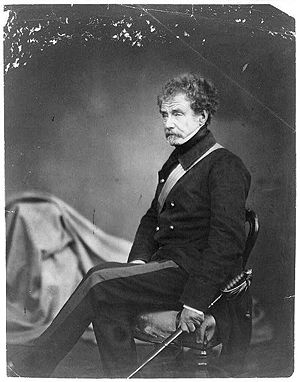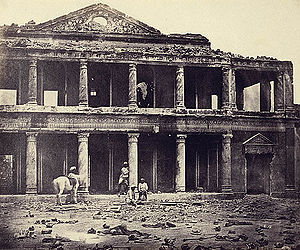- Colin Campbell, 1st Baron Clyde
-
Field Marshal
The Lord Clyde
GCB, KCSI
Lord Clyde in 1855Nickname Sir Crawling Camel Born October 20, 1792
Glasgow, ScotlandDied 14 August 1863 (aged 70)
Chatham, Kent, EnglandBuried at Westminster Abbey Allegiance  United Kingdom
United KingdomService/branch British Army Years of service 1808 – 1860 Rank Field Marshal Unit 9th Regiment of Foot,
60th Regiment of Foot,
93rd (Sutherland Highlanders) Regiment of Foot &
98th Regiment of FootCommands held Highland Brigade
Commander-in-Chief of IndiaBattles/wars Peninsular War
Battle of Vimeiro
Battle of Corunna
Battle of the Bidassoa
Siege of San Sebastián
War of 1812
First Opium War
Second Anglo-Sikh War
Battle of Chillianwala
Battle of Gujrat
Crimean War
Battle of Alma
Battle of Balaclava
Indian Mutiny
Siege of LucknowAwards GCB, KCSI Field Marshal Colin Campbell, 1st Baron Clyde GCB, KSI (20 October 1792 – 14 August 1863) was a British Army officer from Scotland who led the Highland Brigade in the Crimea and was in command of the ‘Thin red line’ at the battle of Balaclava. He later commanded the relief army in the Indian Mutiny of 1857.
Contents
Early life
He was born Colin Macliver, the eldest of the four children of John Macliver, a carpenter in Glasgow, Scotland, and his wife Agnes Campbell.[1] He was educated at the High School of Glasgow, but the age of ten, his mother's brother Colonel John Campbell placed him in the Royal Military and Naval Academy at Gosport. When he was only fifteen and a half, his uncle presented him to the Duke of York. The Duke enlisted the boy under the surname of Campbell, which he adopted for life.[2]
Military career
One year later, aged sixteen, he obtained an ensignancy in the 9th Regiment of Foot through the influence of his uncle. His first opportunity at active service soon came. He fought under Wellington at the Battle of Vimeiro.[1] He later retreated with the rest of Sir John Moore's army to Corunna, and was present at the Battle of Corunna.[1] He fought throughout the Peninsular War, and was severely wounded while leading a storming party in the attack on San Sebastián.[1] He was again wounded at the passage of the Bidassoa[1] and compelled to return to the United Kingdom, where his conspicuous gallantry was rewarded by promotion.
 Colin Campbell with William Mansfield, 1st Baron Sandhurst
Colin Campbell with William Mansfield, 1st Baron Sandhurst
Commands
Campbell served in Nova Scotia with the 7th Battalion, 60th Regiment in the War of 1812.[3] After the peace of 1815, he devoted himself to studying military science. In 1823, he quelled the slave rebellion in Demerara, and two years later bought himself a major's rank.[1] In 1832, he became lieutenant-colonel of the 98th Foot and rendered distinguished service in 1842 during the First Opium War.[1] Campbell next saw action in India, in the Second Anglo-Sikh War of 1848-1849, under Sir Hugh Gough.[1] He was wounded at the battle of Chillianwala. At the decisive victory of Gujrat, his skill and valour contributed largely to the success of the British forces; his "steady coolness and military precision" were highly praised in official despatches. He was made a Knight Commander of the Order of the Bath in 1849, and specially named in the thanks of Parliament.[1]
Crimean War
After further service in India, Campbell returned home in 1853. The next year, the Crimean War broke out, and he accepted the command of the Highland Brigade, which formed part of the Duke of Cambridge's division.[1] The brigade and its leader distinguished themselves very greatly at the Battle of Alma;[1] and with his "thin red line of Highlanders" he repulsed the Russian attack on Balaclava.[1] At the close of the war, Sir Colin was promoted to Knight Grand Cross of the Bath, and elected honorary D.C.L. of Oxford University.
Commander-in-Chief of India
 Interior of the Secundra Bagh after the Slaughter of 2,000 Rebels by the 93rd Highlanders and 4th Punjab Regiment. First Attack of Sir Colin Campbell in November 1857, Lucknow. Albumen silver print, by Felice Beato, 1858.
Interior of the Secundra Bagh after the Slaughter of 2,000 Rebels by the 93rd Highlanders and 4th Punjab Regiment. First Attack of Sir Colin Campbell in November 1857, Lucknow. Albumen silver print, by Felice Beato, 1858.
His military ability had been late in being recognised; but his true worth was soon appreciated. In 1857 what started as a mutiny of sepoy soldiers in India spread to a general insurrection in the north of the areas of India controlled by the East India Company. The initial successes of the rebellion lead Lord Palmerston to offer him the command of British forces there on July 11, 1857. [1] On being asked when he would be ready to set out, Campbell replied, "Within twenty-four hours." He left England the next evening, and reached Calcutta on August 13. After spending over two months in the capital to organize his resources, he started for the front on October 27, and on November 17 relieved Lucknow for the second time. Campbell, however, considered Lucknow a false position, and once more abandoned it to the rebels, retaking it in March 1858. He continued in charge of the operations in Oudh until the embers of the revolt had died away.[1] For these services he was raised to the peerage in 1858 as Baron Clyde, of Clydesdale in Scotland.[4] After returning to the United Kingdom in the next year, he received the thanks of both Houses of Parliament and a pension of £2000 a year.[1] He was promoted to Field Marshal in 1862.
Legacy and assessment
Despite lacking the dash which won Britain so many victories in India, Campbell was regarded as a brave soldier and a careful and prudent leader. The soldiers whom he led were devotedly attached to him; and he commanded unvarying respect. Nicknames given by those who disliked his safety-first style of generalship, included 'Sir Crawling Camel' and 'Old Slowcoach'.
Lord Clyde never married and the barony became extinct on his death in August 1863, aged 70. He was buried in Westminster Abbey. A statue was erected to him in his native town, (see Glasgow's public statues) from whom he had also received the Sword of Honour, one of many he received from throughout Britain. Another statue of him, by Carlo Marochetti, was erected in Waterloo Place, London, in 1867. The town of Clyde, New Zealand was named after him in 1865. The town of Campbellpore (Campbellpur), Attock in present day Pakistan, was named after him in 1908.
See also
References
- ^ a b c d e f g h i j k l m n o T.A. Heathcote, The British Field Marshals 1736 - 1997, Page 60, 1999, ISBN 0 85052 6965
- ^ Archibald Forbes. Colin Cambell. http://books.google.co.uk/books?id=r8pJCWpTDf4C&lpg=PA3&ots=4M38UiTePH&dq=Colin%20Campbell%20Macliver&pg=PA3#v=onepage&q=Colin%20Campbell%20Macliver&f=false. Retrieved 5 February 2010.
- ^ Marjie Bloy, Ph.D. "The Victorian Web: Sir Colin Cambell, 1792-1863". http://www.victorianweb.org/history/crimea/campbell.html. Retrieved 22 February 2010.
- ^ London Gazette: no. 22171. p. 3667. 6 August 1858.
- Sir Owen Tudor Burne, Clyde and Siratlinairn ("Rulers of India" series, 1891)
- L Shadwell, Life of Cohn Campbell, Lord Clyde (1881).
 This article incorporates text from a publication now in the public domain: Chisholm, Hugh, ed (1911). Encyclopædia Britannica (11th ed.). Cambridge University Press.
This article incorporates text from a publication now in the public domain: Chisholm, Hugh, ed (1911). Encyclopædia Britannica (11th ed.). Cambridge University Press.
External links
- Archival material relating to Colin Campbell, 1st Baron Clyde listed at the UK National Register of Archives
Military offices Preceded by
Sir Patrick GrantCommander-in-Chief, India
1857–1861Succeeded by
The Lord StrathnairnPeerage of the United Kingdom New creation Baron Clyde
1858–1863Extinct Categories:- British Field Marshals
- British Army personnel of the Napoleonic Wars
- British military personnel of the First Opium War
- British Army personnel of the Crimean War
- British military personnel of the Second Anglo-Sikh War
- British military personnel of the Indian Rebellion of 1857
- Knights Grand Cross of the Order of the Bath
- Knights Companion of the Order of the Star of India
- People from Glasgow
- People educated at the High School of Glasgow
- 1792 births
- 1863 deaths
- British army personnel of the War of 1812
- 98th Regiment of Foot officers
- Royal Norfolk Regiment officers
- North Staffordshire Regiment officers
- Scottish soldiers
- Barons in the Peerage of the United Kingdom
Wikimedia Foundation. 2010.
